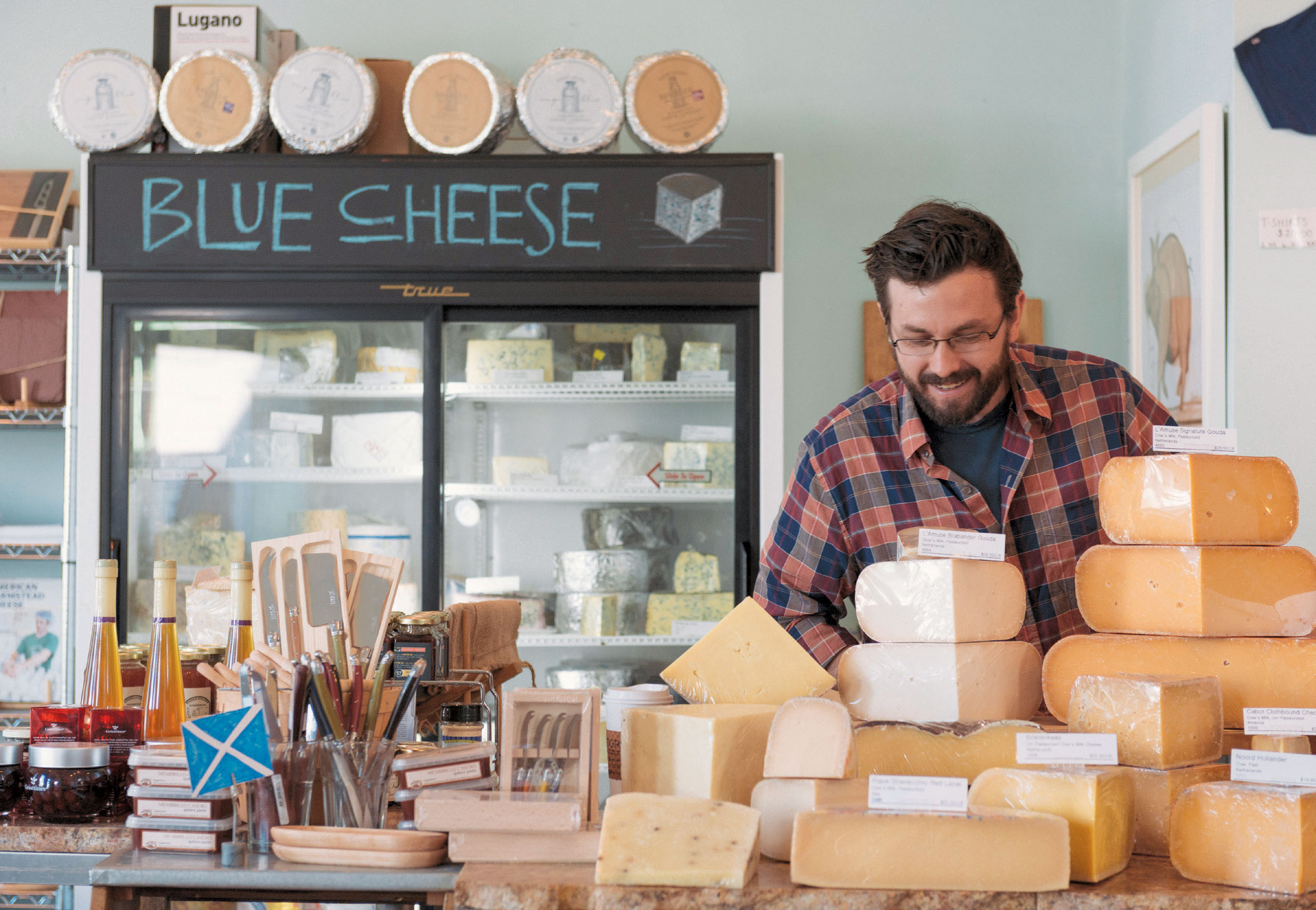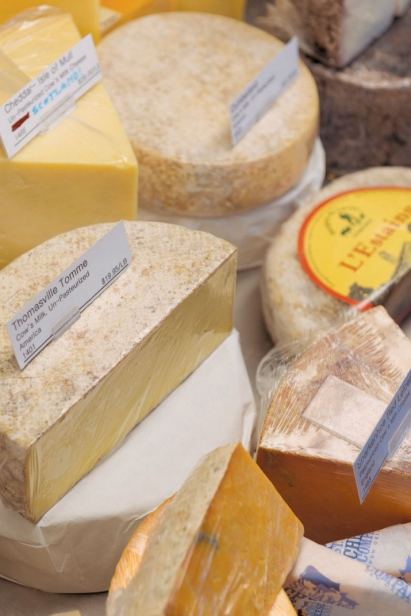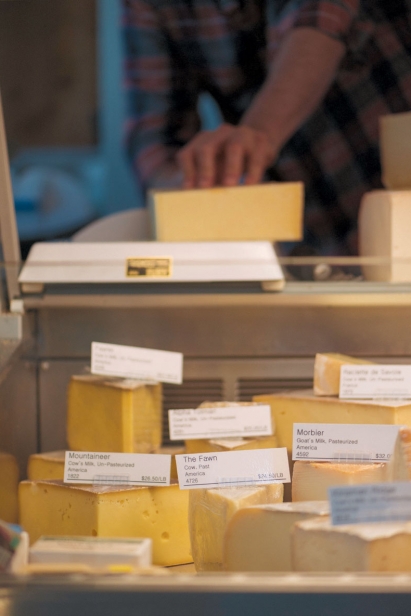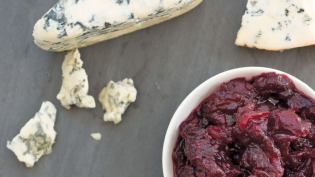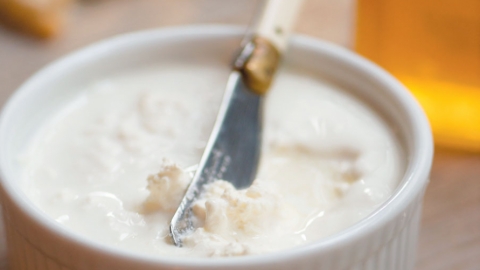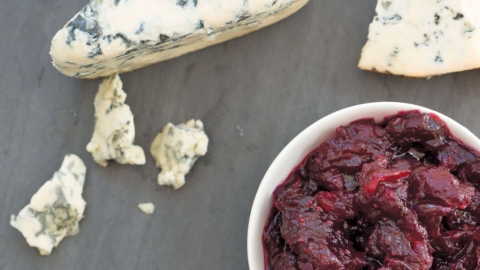A Few Words on Curds
Justin Trosclair, the cheesemonger and general manager at St. James Cheese Company, won the Best Cheesemonger in the World title at the Cheesemonger Invitational in 2013. A Marrero native, Justin has also worked in the cheese department at Whole Foods and as a cheesemaker at Haystack in Colorado.
Liz Thorpe is the author of The Cheese Chronicles. Her consulting firm, The People’s Cheese, organizes the Cheesemonger Invitational. She recently moved to New Orleans from Brooklyn and is currently writing a second book about cheese.
Edible New Orleans: You are both accomplished cheese experts who also live in New Orleans, which is not known for a robust commercial cheesemaking culture.
Liz Thorpe: St. James is the only game in town when it comes to [retail] cheese. There is very little going on—being made—that I know of in Louisiana.
Justin Trosclair: [St. James has] investigated this. And when I say that we’ve investigated it, I don’t mean that we’ve investigated local producers. We’ve investigated going into production. Here’s why it’s hard for us: One, there are only a couple of producers or farmers who are making cheesemaking-quality milk. There’s Ryals [Rocking R Dairy], there’s Mauthe’s Progress [Dairy Barn] and there’s maybe a handful of smaller guys. They’re an hour away from New Orleans. So, we’d have to move out there and we’d have to have a plant out there, which for us is a little bit tricky because we’re a really small company. I’d have to relocate, which I don’t really want to do. I’d sort of be like a lone soldier out there. It isn’t a great agriculture community. If you’re in California in the middle of nowhere making cheese, you’ve got all these cheesemaking buddy neighbors and great growers and what-not and you feel part of a community. We’re just getting there, I feel like, in Louisiana. But it’s great, because we are making progress, especially with Good Eggs.
LT: But if there were someone who wanted to live in the sticks an hour away from New Orleans …
JT: … you could be making cheese. But then you put this business plan together, you build this company and you need to make a lot of cheese to make a profitable business. I think that’s where a lot of small cheesemakers go wrong. They don’t anticipate the amount of cheese they need to make to make a comfortable living. By comfortable I just mean that you don’t want to kill yourself working your ass off.
LT: Even to break even you’re talking about making 25,000– 40,000 pounds of cheese a year.
JT: The only way you can make it small is if you’re on the farm, making cheese, and you have other ventures. But you’re killing yourself. I’ve been in it; I’ve seen people. They kill themselves. It’s a serious endeavor—it’s not like “I’m just going to go make some cheese,” though that’s how a lot of people get into to it. So then you say, “I want to make 40,000 pounds of cheese.” You’ve got two sources: Mauthe’s and Ryals. That’s it. So if one of them dries up, if the other guy doesn’t want to be in business with you, you’re screwed and you’ve built a company that’s completely reliant on another company that’s not yours. And then in the summertime, the milk supply totally dries up.
LT: Unless you want to build a farmstead of your own. I assumed there wasn’t cheesemaking in Louisiana because the weather was just prohibitive from June to September. You could be a seasonal dairy. There’s a really great cheesemaker in Virginia called Meadow Creek Dairy. They’re seasonal not because of the weather but because of they’re a farmstead operation and, basically, their animals need a break. They don’t make milk all year round, so it’s possible to do that and to do that successfully. I mean, it’s kind of rare with cows, but possible.
JT: I think the short answer is that it’s complicated. It’s not an easy thing to do—not a lot of milk, it’s hot weather.
LT: If you look at Europe, there are regions known for goatand sheep-milk cheeses, and those are the regions of Europe that have more marginal climates. Generally very hot and very dry. Not humid like Louisiana, but very hot and dry. Like punishingly hot and dry, like prone to drought every summer—that’s very typical and there’s a reason those animals are raised there and it’s because those animals can take that kind of environmental extremity that cows can’t take. So, I would sort of expect that you would see fewer cow operations here, but you would see more goat operations. I did find, in the bit of traveling and research I did a bunch of years ago for my last book, that there’s this stigma in the South about goats. Goats were what poor people had. Goats were what you had when you couldn’t afford a cow to milk. And there was this idea that goats were dirty, they ate garbage, and the general public wouldn’t want to buy goat cheeses. Goats would do really
well here.
ENO: Morgana King has a goat landscape operation here called Y’Herd Me?
JT: I heard about that!
ENO: A small herd of goats clears unwanted vegetation from overgrown property. The whole thing seems pretty cool.
LT: No, goats are awesome. They’re my favorite of the milking animals by far. I think that’s what’s awesome about goats and also part of why they have this weird negative association—because they will clear the land. They will eat and they will mow through whatever is in front of them.
ENO: Goat milk cheese wasn’t even produced commercially in the U.S. until 1981. Now there are hundreds of goatmilk cheeses produced here. I can only imagine that there are now hundreds and hundreds of “American cheeses” on the market that aren’t American cheese these days.
LT: I come in to St. James and I’m a cheese expert. I’m writing a book about cheese so I’m supposed to know more about cheese than anybody, but there are so many cheeses on the market. Justin, your job is to select cheeses for St. James and for your restaurant clients. What is your system?
JT: We’ll give almost anything a shot. [St. James co-owner Richard Sutton] is really good about sending people off to visit producers and festivals. We probably spend way more money than we should as a small cheese shop to send people off. Our goal is to have visited all of the producers of the cheeses that we sell. It’s a little bit of a lofty goal but we’ve done a lot of them.
LT: That’s an awesome goal. That’s not the attitude everywhere. I think that’s a really enlightened attitude … to make the investment and support your employees in getting out there. You do find new things, but that’s what makes it fun.
JT: So, we get out there and taste new things. If we like it, we’ll bring it in. We all give it the basic taste test. Once you accumulate this list of producers, you just have to rotate through them. For example, goat cheeses. I can’t carry all the goat producers that I like all time. We’re trying to keep some Southern stuff since we don’t have hardly any local cheese. So, I’ll do a Belle Chevre order, and once I run out of that I’ll do a Prodigal order … Unless a restaurant is listing [a cheese] on their menu. We do a lot of wholesale, so if a restaurant lists it on their menu, then we have to have it all the time. That’s our strategy. It’s really hard to manage. The cheesemongers have to be on their toes and kind of know about all this random stuff we bring in. It’s not the most efficient way to do things, but we want to try to spread the love to the producers we like.
LT: I think that’s the beauty of being a smaller operation: You can change it up. It makes for a very different experience as a customer.
JT: Visiting producers is really important to me because every time you visit a producer your perception of that producer changes a little bit, whether it improves or takes a step down. Sometimes you go to a place and you’re, like, ‘Whoa, I didn’t realize that they’re just churning out as much as they’re doing.’ It’s still a great cheese, but I’m going to think about it a little bit differently.
LT: Conversely, when you can go to a place, [your opinion of] cheeses that you might have written off as kind of boring or kind of predictable [can change.] Wisconsin cheeses are thought of as pedestrian and predictable and boring— they’re nothing special. They aren’t these bespoke handcrafted things. They are factory cheeses. And then I visited some of those factories, and they are factories, but they’re run by guys who have made cheese their whole lives whose fathers made cheese their whole lives, whose grandfathers made cheese their whole lives, and it was sort of amazing the wealth of knowledge these people had. It made me feel very different about their Colby or their block Havarti.
JT: I typically have that experience more than the disappointed experience. Usually, interesting people are attracted to cheese.
ENO: Going back to American cheese, how does a cheesemonger make a grilled cheese sandwich? Are you traditionalists or do you deviate?
JT: Is this one of those things where you’re trying to get a quote, to get one of us to say we like Velveeta? ’Cause I like Velveeta. I grew up with it.
LT: I don’t actually like Velveeta but I didn’t grow up with it. I do really, really like powdered macaroni and cheese.
JT: I agree with you about the powdered cheese thing. I think that there’s some from Italy—like Salva Cremasco is a good example, or Roccolo—they have that powdered cheese flavor.
LT: It’s the boxed macaroni and cheese flavor that I really like in cheese and it is a descriptor I’m using right now in my writing. It is this essential, inherent, cheesy quality that transcends country milk style. It reminds me of macaroni and cheese in a good way.
JT: And there aren’t that many cheeses that have that flavor. And I’ve felt kind of guilty using that as a descriptor when I’m selling cheese. I would say, “It’s a very cheesy cheese, like macaroni and cheese.” It seems like a cop out, like I should think of some more clever words. I don’t think there is any other way to say it.
LT: Like, who doesn’t like that? I write a cheese column for Serious Eats and I’m working on a column about grilled cheese because gourmet grilled cheeses really annoy me. Also, there are some cheeses that are exceptional melting cheeses. There is a quality that I believe everyone wants in a grilled cheese and that is when you break the bread and you pull it apart you get gooey, ropey strands. To me, that is what Velveeta does for people. I want melted goo. And I don’t want it to be greasy. There are categories of cheese that do that pretty consistently, like alpine-style cheeses. I’m not against upgrading and putting a fancy or expensive cheese in a grilled cheese sandwich. You can use a smaller amount since they are more flavorful.
ENO: I want ropey gooeyness from the inside, but I like the brown cheese that hits the pan on the outside. And that’s the part that Velveeta doesn’t give me.
JT: I don’t make grilled cheese at home. Although my favorite grilled cheese ever that I tried to duplicate for a bit … have you ever had the one at Borough Market? It’s the Neal’s Yard guy …
LT: Oh, the guy that only makes the grilled cheese sandwiches? And he makes raclette too.
JT: Yes, so he does pain Poilâne, which is, like, this French sourdough. Anyway, this country rustic bread, this shredded Montgomery’s Cheddar, like, one of the greatest cheddars in the world. Then he cuts it with a melty raclette-style cheese.
LT: You get the flavor from the Monty’s but you get the gooey from the other.
JT: And finely diced red onion. It gets those brown crusty things around the edge.
LT: I think the grating is also a key thing for grilled cheese. In order to get consistent melt, you need consistent cheese. You can’t get that if you are slicing, so grating is key. You can also blend cheeses if you grate.
JT: You can blend homogenously, rather than randomly.
LT: I think, don’t bother making a grilled cheese sandwich unless you are willing to grate it.
ENO: What advice do you have for creating great cheese pairings?
JT: I feel like when people ask that question [about pairings], they want to experience whatever the expert or the monger experiences. We have the capacity to sit there all day for as long as we need to and try to make these pairings work and make sense. Whereas when you are on the other side of the counter, which I have been, it is really frustrating because you read all these food magazines, no offense, and they’re just, like, “This goes with this and this goes with this” and it seems so random.
ENO: Perhaps a general guideline would be more helpful than a hard rule.
LT: This is why the pairing component [of the Cheesemonger Invitational] is so interesting. It’s getting up and it’s saying, “When I taste this beer, I get a lot of chocolate and coffee notes and I picked Vermont Creamery Cremont because that reminds me of a dollop of cream in my coffee.” It’s sort of, like, “OK, maybe I don’t have that beer and maybe I don’t have that cheese, but you are exposed to a thought process and when it’s the thought process of someone who tastes these things every day, day in day out, for a living, I think that’s when you really learn as a consumer and as an enthusiast. Other mongers also are exposed to the thinking of their colleagues and I think that’s where you really start to learn some methodologies for approaching pairings. There is this idea that there’s a right and a wrong way and that there’s a matrix with the ultimate answer, but it’s such a subjective thing and such an experiential thing that what’s perfect for me is not going to be perfect for you. This is an annoying cheese person’s answer to it—that there is no perfect pairing. The thing that I’ve been realizing about cheese recently is— you know, I’ve worked in cheese now for 14 years, so this has been a big revelation for me and it’s probably going to sound really obvious—the variability in cheese is so phenomenally great. I’m working on this book and I’m tasting cheese and every time I taste the cheese it tastes different. The same cheese from the same maker even sold by the same retailer and it’s different every time. Beer and wine are not like that. Wine people talk about vintages and so you get one year where everything’s going to be consistent but cheese changes from wheel to wheel to wheel, and how it’s stored and handled has a huge impact. I just think that that’s another thing to bear in mind with pairing. We could sit here and have an amazing pairing and then try it again next week and be, like, “Hmm, it’s OK. It’s good, it’s fine, but last week it blew my mind.”
JT: Not only does it change wheel to wheel, but it also changes depending on when you eat that one wheel. Is it right when you got it in? Is it right on the edge of its life?
LT: I like pairings that are also sort of unexpected. I think there is something so wonderful about it. Conventional wisdom says this and this go well together— and probably they do; clichés are clichés for a reason. In cheese, you hear people talk about getting the most buttery, cream-enriched triple cream and pairing it with champagne. That’s a classic pairing. The bubbles cut the fat. That’s all true and it’s really nice. But that flavor profile that I love in champagne is that toasty quality and I remember the first time I had a bubbly wine with that toasty flavor profile and an aged mountain cheese. Actually it was Gruyere, which in this day in age is not that radical or crazy of a cheese. Justin sells a million Gruyere-style cheeses that are way more radical, but it was totally the opposite of conventional pairing wisdom and it was like eating buttered toast and the whole idea of bubbles cutting fat totally applied because the cheese was really dense and firm. It just wasn’t what anyone every told me went together and it was so delicious.
ENO: So, if you are bringing cheese to a New Year’s Eve party, where there is plenty of champagne or other bubbly wine, that’s the cheese you bring to impress everyone.
LT: You bring the most special—some shops call them mountain cheeses or alpine cheeses, but France or Switzerland— I would go to Justin and be, like, “What do you have?” They make a Gruyere Alpage for only a few months of the year, so that would be a notch up, but in the same vein. Yes, I would totally bring that. Also, everybody likes that style of cheese.
JT: Total crowd pleaser. I think more people like more cheeses than they think they do. I think 90% of cheeses, unless you have a specific “I don’t like blue” or “I don’t like goat” thing, are party appropriate. Usually when people say they don’t like goat, they mean that they don’t like fresh, lactic tangy goat and when they say they don’t like blue they mean they don’t like that biley, overly acidic crap.
ENO: Clearly, you all are always asked to bring the cheese plates when you go to parties, right?
LT: Yes.
JT: Nobody asks. They just expect it.
LT: Justin shows up cheeseless and they are, like, “Get out now.”
Interview by Stephanie Jane Carter
*This interview has been condensed and edited.


